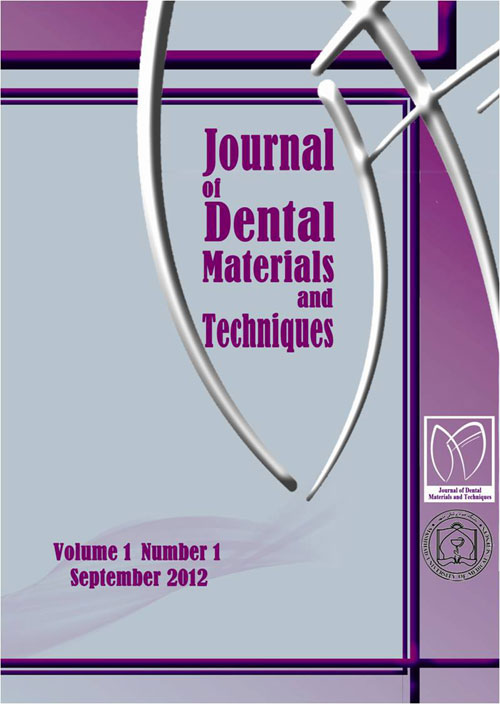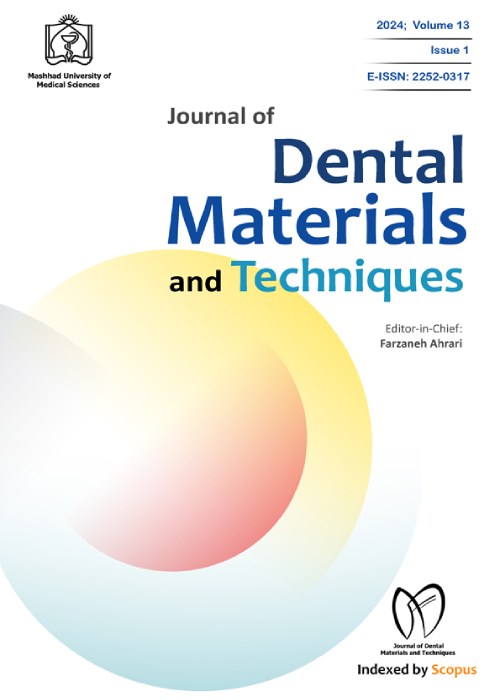فهرست مطالب

Journal of Dental Materials and Techniques
Volume:10 Issue: 4, Autumn 2021
- تاریخ انتشار: 1400/10/18
- تعداد عناوین: 8
-
-
Pages 185-192
Naturally occurring in citrus fruits, citric acid is categorized as a weak organic acid, which may exist both as a monohydrate or in an anhydrous form. In biochemistry, this organic acid acts as an intermediate in an essential metabolic process in all aerobic organisms called the Krebs cycle. The literature on citric acid in the context of endodontics up to June 2020 was reviewed using PubMed and MEDLINE. This review aimed to address the antibacterial efficacy of citric acid on endodontic microbiota, its effectiveness on the smear layer, the effects of its toxicity on fracture resistance of dentin, as well as the effectiveness of this acid on the removal of intra-canal medicaments. This report also addressed citric acid-containing endodontic irrigants.
Keywords: Antibacterial activity, Calcium hydroxide, citric acid, smear layer, Toxicity -
Pages 193-197IntroductionThis study was conducted to compare the cyclic fatigue (CF) resistance of One G, WaveOne Gold Glider, T-Endo MUST tg, One G and VDW.ROTATE nickel-titanium (NiTi) glide path (GP) instruments in a simulated canal of 900 and a 3-mm radius canals at root canal temperature.MethodsSixty NiTi files were used for the fatigue testing in stainless steel canals compatible with instrument sizes until fracture occurred (n=15): One G (#14/.03), WaveOne Gold Glider (#15/.02), T-Endo MUST tg (#13/.04), VDW.ROTATE (#15/.04), The number of cycles to fracture (NCF) was calculated for each instrument, and the lengths of the detached fragments (LDF) were measured. Data were statistically analyzed using the Kruskal–Wallis analysis and Mann-Whitney U tests at the %95 confidence level.ResultsThere were significant differences in the CF resistance among the groups (P < 0.05), the highest to lowest NCF values of the files as follows: T-Endo MUST tg, WaveOne Gold Glider, VDW.ROTATE, and One G. There was no significant difference within LDF among the groups P> 0.05).ConclusionThe T-Endo MUST tg files had the highest and the One G files had the lowest CF resistance in a simulated canal of 900 and 3-mm radius canals at root canal temperatureKeywords: Cyclic fatigue, Glide path, One G, T-Endo MUST, VDW.ROTATE, WaveOne Gold Glider
-
Pages 198-205IntroductionThe aim of this study was to evaluate the effect of coffee staining and home bleaching agent on the color stability of stained CAD/CAM ceramics.MethodsForty specimens were prepared from feldspathic ceramic (CEREC Blocs) and hybrid nano-ceramic (Cerasmart) CAD/CAM blocks (N=40). The polished specimens were ultrasonically cleaned in distilled water and then, immersed in coffee for seven days. The stained specimens were divided into four subgroups (n=10) according to their type of ceramic and bleaching treatment; CEREC control, CEREC bleaching, Cerasmart control and, Cerasmart bleaching. The home bleaching agent (Opalescence PF 16%) was applied to specimens of bleaching groups for seven days. Control groups did not take any bleaching procedure and were placed in distilled water during this period. Then the specimens were immersed in coffee for seven days again for staining susceptibility. CIELAB parameters were recorded at four times; initial color, 1-week coffee staining, after bleaching, and coffee staining after bleaching with a dental spectrophotometer (VITA Easyshade). Color changes between each step were calculated as ΔE values. The data were statistically analyzed with t-test and Kruskal Wallis test.ResultsAfter 1-week coffee staining the highest ΔE values were obtained from Cerasmart (p<0.001). The bleached Cerasmart group showed significantly higher color change values compared to Cerasmart control and both CEREC groups (P<0.05). No significant differences were found between control and bleached groups in both Cerasmart and CEREC groups after coffee immersion.ConclusionCoffee staining and 16% carbamide peroxide bleaching significantly influenced the color of resin ceramic CAD/CAM materials.Keywords: CAD, CAM, Bleaching, Staining
-
Pages 206-213IntroductionThe aim of this study was to compare microleakage in Class V restorations using different composite resins and application techniques.MethodsIn this study, 60 cavities were prepared on the buccal and lingual surfaces of samples, 3 mm length (mesio-distal), 3 mm height (cervico-occlusal) and 2 mm depth. Samples were randomly divided into 6 groups. In Group 1, Grandio (Voco GmbH, Cuxhaven, Germany) was used with bulk technique, in Group 2 by horizontal incremental technique and in Group 3 by oblique incremental technique. SonicFill (Kerr, CA, USA) in Group 4, Filtek Bulk Fill Posterior Restorative (3M ESPE, st. Paul, USA) in Group 5, and Estelite Bulk Fill flow (Tokuyama, Japan) in Group 6 were used with bulk technique. After thermal cycle, samples were incubated in 0.2% methylene blue solution for 24 hours. They were sectioned longitudinally from the middle of cavity (buccolingually). Microleakage was evaluated by stereomicroscope (Nikon SMZ25, Tokyo, Japan). Kruskal-Wallis and Mann-Whitney U tests were used for statistical analysis.ResultsMicroleakage at the cervical margin was higher than the occlusal margin. There was no statistically significant difference between groups at the occlusal margin, but there was a significant difference between groups at the cervical margin (P₌0.02). In Groups using incremental techniques, less microleakage was observed. There was no statistically significant difference between groups using bulk technique.ConclusionThe use of incremental techniques in the restoration of cervical lesions may reduce microleakage.Keywords: Microleakage, Bulk Fill composites, Class V restorations
-
Pages 214-223IntroductionIn case of severe destruction or total coronal loss of tooth structure the retention of the core is achieved by embedding a post into the root canal. There are different prefabricated posts for buildup of coronal tooth structure. There is no same opinion about which post is more effective for root canal treatment (RCT) tooth. The aim of this study is to determine the effect of post material on the stress distribution of RCT maxillary canine by finite element analysis (FEA).MethodsA canine tooth was mounted inside a resin. A 3D scan of the mounted tooth was prepared by cone-beam computed tomography (CBCT) method. The Mimics Medical and Solidworks software was applied to provide an appropriate 3D model of the canine tooth. Post core crown restorations with three different types of prefabricated post, glass fiber, zirconia, and titanium, were considered for the restoration. An oblique load of 100 N was applied on the cusp and then FEA was performed by ABAQUS software.ResultsThe results of FEA showed that in all models the maximum principal stress occurred at the crest area. The stress decreased in dentin and increased in the post and cement interface by increasing of post elastic modulus.ConclusionIn according to FEA results it could be deducted that the post stresses are increased, by increasing of post elastic modulus, as well as the post material has a small contribution to the stress of the cervical area.Keywords: canine, Finite elements analysis, Prefabricated post, stress, CBCT
-
Pages 224-231IntroductionThe aim of the present study was the comparison of radiopacity of different resin cement types using direct digital radiography by calibrating the calculations on the radiogram according to the dead pixel value on the phosphor plate for the first time in literature.MethodsThe radiopacities of currently used ten different resin cements(G-CEM, I-CEM, Choice 2, Duo Link, TheraCem, eCEMENT DC, MaxCem Elite Chroma, BisCem, NX3, and Maxcem Elite), enamel and dentin were compared with the densitometer. The digital radiographs were acquired and Image J software was used to convert the images into numerical data for analysis. After the dead pixel calibration, the equivalent aluminum thickness value of each sample was calculated by the correlation analysis method.ResultsAccording to test results, although there was no significant difference between G-CEM and I-CEM, all the materials, enamel and dentin had a significant difference from each other. MaxCem Elite had the highest radiopacity while G-CEM had the lowest.ConclusionseCEMENT DC, MaxCem Elite Chroma, BisCem, NX3, and Maxcem Elite had higher radiopacity than dentin. Those with lower radiopacity than dentin (G-CEM, I-CEM, Choice 2, Duo Link, and TheraCem) should be carefully used in both subgingival located or radiolucent restorations and implant-supported prostheses. Dead pixel calibration enables materials to be evaluated more accurately and this method will also make it possible for the first time in literature to compare the same samples with each other on different phosphor plates.Keywords: Calibration, dead pixel, Radiopacity, Resin cement
-
Pages 232-241IntroductionRestorative materials are under constant loadings from mastication hence, it is important to have the knowledge of structural properties of the restorative materials to have long-term success on restorations. Therefore, the aim is to compare the nanohardness and elastic modulus values of various restorative materials.MethodsDisc-shaped samples were prepared from a high viscosity glass ionomer - Equia Forte Fil (EFF), a compomer - Dyract (DXP), a hybrid ionomer - Geristore (GS), a giomer bulk-fill - Beautifil-Bulk (BB), two bulk-fill composites - Venus Bulk-fill (VB) and Sonic Fill 2 (SF), and a nanohybrid composite - Z250. Samples of each of the tested materials (n=9) were examined under nanoindentation to evaluate elasticity modulus (Er) and nanohardness (Hnano) scores. One of the samples had undergone through scanning electron microscopy (SEM) evaluation. Data were analyzed statistically using the Kruskal-Wallis test.ResultsSF had the highest elasticity modulus, followed by Z250 and DXP, without any statistical differences. However, GS had the lowest elasticity modulus, followed by EFF (P<0.001). Among nanohardness scores, there is no significant difference between VB, EFF, DXP, Z250, and BB groups. While SF showed the highest, GS had the lowest nanohardness scores. SEM images showed the differences between filler sizes and shapes.ConclusionMain structural differences between glass ionomer-based and resin-based materials determined significant differences among related parameters of the restorative materialsKeywords: Resin composites, Glass ionomers, Hybrid materials, nanoindentation
-
Pages 242-250IntroductionThe aim of this study was to assess various smile line problems and treatments and to assess the patients’ satisfaction after treatment.MethodsThis cross-sectional study assessed patients who had smile line problems. Various smile line problems included vertical maxillary excess (VME), muscle hyperactivity, gingival hyperplasia, short lip, bimaxillary protrusion, asymmetric muscle hyperactivity, maxillary canting, and tooth deformity. All patients filled out a questionnaire one year after the procedures for 23 assessments of satisfaction. The level of satisfaction was evaluated using a visual analog scale (VAS): 0-3 dissatisfaction, 4-7 acceptable, and 7-10 desirable.ResultsOne-hundred thirty-seven patients were included in this study. The highest level of satisfaction was noted in patients who had tooth deformity, VME with passive eruption, and gingival hyperplasia or passive supra-eruption (7.75±0.46, 7.66±0.72, and 7.50±0.55, respectively). The lowest level of satisfaction was noted in patients who had asymmetric muscle activity, muscle hyperactivity, and VME+ muscle hyperactivity (4.25±0.96, 4.33±0.78 and5.00±1.09, respectively).ConclusionPatients with soft tissue problems of the smile line may have low 41satisfaction especially when temporary treatments such as botulinum toxin are used for treatment. Surgery of the hard tissues may result in moderate to high satisfaction in patients with smile line problems.Keywords: Smiling, Face, esthetics, Facial Muscles


